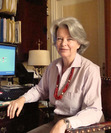Claude Forthomme's Blog, page 31
April 20, 2014
Book Cover for a Cli Fi Novel: Which is Best?
Cli Fi, or Climate Fiction, is rapidly becoming a widely accepted term to designate a new genre of books dealing with Climate Change but not only: many elements taken together – like the demographic explosion, growing income inequality, urbanization and the rapid industrialization of the Third World – contribute to threaten our survival on Earth.
Personally, I am convinced that things will get from bad to worse in about 200 years and go kaput in 600 years, if we don’t do anything about it.
And that’s the worst of it: because it is a relatively slow process, a lot of us don’t feel the urgency and even deny that the process is going on. Result: on a political level things are moving at a snail’s pace and the end of the world could really sneak upon us in 600 years!
The involvement of literature in the Climate Change debate is growing, and one UK academic, Dr. Adeline Johns-Putra recently noted that in the past eight years, at least 150 novels dealing in one way or another with the likely future collapse of humanity have been published, fifty of them pure "cli-fi" (I blogged about it here).
In this regard, the following email exchange between Dan Bloom and me on 18 April 2014 is illuminating:
Dan Bloom to me : After reading the Rodge Glass piece in the Guardian last May, I emailed Dr. Adeline Johns-Putra, Reader in English Literature at the University of Surrey in the UK, asking her what she thought of the new term, and she replied:
''I think climate change fiction (or 'cli-fi') has, in just a few years, moved beyond simplistic apocalypse scenarios to engage intelligently with questions of science and policy (Kim Stanley Robinson's Science in the Capital trilogy) and environmental justice (for example, Barbara Kingsolver and Paolo Bacigalupi, in very different ways). By making us 'live' both the devastating impacts of climate change and ways of dealing with these, these novels can't help but intervene in the ongoing debate on climate change policies .''
My response: I love that: "these novels can't help but intervene in the ongoing debate on climate change policies"...Makes me happy, I certainly hope my Forever Young will be viewed that way, I conceive of it as a contribution to the debate though my main objective always remains one of a story teller at heart!
Dan's closing remark : Exactly, and your book WILL contribute....I now see the world cli fi community as TEAM CLI FI, with no leader, no Number One Bestseller, but rather a community of writers worldwide who will be contributing, each in their own way, to the larger worldwide global discussion. So YES, you are on the TEAM CLI FI now...Go go go!
Hey, Dan, I’m very happy to be on the Cli Fi Team as a story-teller and…go go go! Which is why I am working on the cover of my cli-fi/sci-fi book Forever Young. The draft is finished, fully edited – the book will be soon published, it’s time to finalize the cover.
And I need your help, dear reader. This is a difficult challenge, there are no established norms for the covers of Cli-Fi novels...From New York submerged in water (like on the cover of Nathaniel Rich's novel Odds against Tomorrow) to the bucolic charm of Barbara Kingsolver's novel (about a monarch butterfly invasion).
What do you think of those two book covers? I’ve set up a poll below where you can answer, voting for your favorite.
Version 1, through a porthole:

Version 2, the full woman:

Why a woman instead of space ships and distant planets as is the norm for science fiction?
Because space travel is not the point of the book. One particular woman is – she’s a major character, her name is Alice. She’s young and beautiful, warm-hearted and very, very independent. One of my beta readers, Bob Rector, who also happens to be a hugely talented writer (he just published Unthinkable Consequences that is fast becoming a best seller), quite literally fell in love with her and asked me to put her on the cover.
So I did a portrait of her, here it is:

To help you decide which cover is best, here’s a quick word about the book:
Forever Young, a serialized novel in 4 episodes, is set 200 years from now, in a world divided between the ultra rich, the One Percent, who live in gated communities and the others who don’t and suffer the full onslaught of pollution and Climate Change. The One Percent are the only ones who can afford all the advances of technology, in particular the exclusive Age Prevention Program (APP), whose members wear special Life Watches that enable them to expand their life span to the genetic maximum of some 140 years and look young till the day they die.
The novel interweaves several plot lines. The first chronicles the love triangle between Alice, a young Swiss nurse, beautiful and independent, Lizzie, a talented golf player, the descendant of the mythical Tiger Woods, and Jamie, an ambitious reporter for the World and US Post, an amalgam of the Huffington Post and the New York Times.
The second covers the rising threat to life on earth, as humanity is headed for extinction; there are only two options to save humanity, both reserved to One Percenters: one, escape to another world, a pristine exoplanet a thousand light years away; the other, retreat to Antarctica, the last virgin continent, and wait for life to extinguish itself before resettling Earth. As a result, a ruthless rivalry develops between the tenants of the “hibernation party” that aims to stay on Earth and those of the “immortality trip” bent on escaping to another planet.
The third follows the murderous attempts of one determined 99 Percenter, a retired Blue Beret who has served all his life in the United Nations Peace-keeping Forces and is hell-bent on carving a place for himself in the Age Prevention Program.
And here’s the poll:
Which Cover for FOREVER YOUNG do you prefer?Version 1, through the portholeVersion 2, the full womanNone of the two pollcode.com free polls
Please vote, let me know what you think in the comments below (not on the pollcode site, I may miss it there). To show my gratitude for your help, I'll send an advance copy of the book (digital - pdf) to the three best and most useful comments (lottery drawn if there are too many!).
Again, many thanks for the help, and Happy Easter to all who celebrate today!
Post scriptum. Just as I closed this post, I came across an article in the New York Times Magazine, about the amazing "Uncivilization" festival organized in the UK by the Dark Mountain Project led by British author Paul Kingsnorth (see here).

His vision of a future "global collapse" is exactly the one I envision in Forever Young - a future that will come slowly but inexorably and that you have to live with...like Alice and her friends. Yes, there is a good reason why the sky above Alice is blood red, or alternatively, why she is plunged in a frightening sick-greenish world...
Related articles Global warning: the rise of 'cli-fi'(guardian.co.uk)
Global warning: the rise of 'cli-fi'(guardian.co.uk)
 This One Simple Graphic Explains The Difference Between Climate Science And Climate Politics(thinkprogress.org)
This One Simple Graphic Explains The Difference Between Climate Science And Climate Politics(thinkprogress.org)










Personally, I am convinced that things will get from bad to worse in about 200 years and go kaput in 600 years, if we don’t do anything about it.
And that’s the worst of it: because it is a relatively slow process, a lot of us don’t feel the urgency and even deny that the process is going on. Result: on a political level things are moving at a snail’s pace and the end of the world could really sneak upon us in 600 years!
The involvement of literature in the Climate Change debate is growing, and one UK academic, Dr. Adeline Johns-Putra recently noted that in the past eight years, at least 150 novels dealing in one way or another with the likely future collapse of humanity have been published, fifty of them pure "cli-fi" (I blogged about it here).
In this regard, the following email exchange between Dan Bloom and me on 18 April 2014 is illuminating:
Dan Bloom to me : After reading the Rodge Glass piece in the Guardian last May, I emailed Dr. Adeline Johns-Putra, Reader in English Literature at the University of Surrey in the UK, asking her what she thought of the new term, and she replied:
''I think climate change fiction (or 'cli-fi') has, in just a few years, moved beyond simplistic apocalypse scenarios to engage intelligently with questions of science and policy (Kim Stanley Robinson's Science in the Capital trilogy) and environmental justice (for example, Barbara Kingsolver and Paolo Bacigalupi, in very different ways). By making us 'live' both the devastating impacts of climate change and ways of dealing with these, these novels can't help but intervene in the ongoing debate on climate change policies .''
My response: I love that: "these novels can't help but intervene in the ongoing debate on climate change policies"...Makes me happy, I certainly hope my Forever Young will be viewed that way, I conceive of it as a contribution to the debate though my main objective always remains one of a story teller at heart!
Dan's closing remark : Exactly, and your book WILL contribute....I now see the world cli fi community as TEAM CLI FI, with no leader, no Number One Bestseller, but rather a community of writers worldwide who will be contributing, each in their own way, to the larger worldwide global discussion. So YES, you are on the TEAM CLI FI now...Go go go!
Hey, Dan, I’m very happy to be on the Cli Fi Team as a story-teller and…go go go! Which is why I am working on the cover of my cli-fi/sci-fi book Forever Young. The draft is finished, fully edited – the book will be soon published, it’s time to finalize the cover.
And I need your help, dear reader. This is a difficult challenge, there are no established norms for the covers of Cli-Fi novels...From New York submerged in water (like on the cover of Nathaniel Rich's novel Odds against Tomorrow) to the bucolic charm of Barbara Kingsolver's novel (about a monarch butterfly invasion).
What do you think of those two book covers? I’ve set up a poll below where you can answer, voting for your favorite.
Version 1, through a porthole:

Version 2, the full woman:

Why a woman instead of space ships and distant planets as is the norm for science fiction?
Because space travel is not the point of the book. One particular woman is – she’s a major character, her name is Alice. She’s young and beautiful, warm-hearted and very, very independent. One of my beta readers, Bob Rector, who also happens to be a hugely talented writer (he just published Unthinkable Consequences that is fast becoming a best seller), quite literally fell in love with her and asked me to put her on the cover.
So I did a portrait of her, here it is:

To help you decide which cover is best, here’s a quick word about the book:
Forever Young, a serialized novel in 4 episodes, is set 200 years from now, in a world divided between the ultra rich, the One Percent, who live in gated communities and the others who don’t and suffer the full onslaught of pollution and Climate Change. The One Percent are the only ones who can afford all the advances of technology, in particular the exclusive Age Prevention Program (APP), whose members wear special Life Watches that enable them to expand their life span to the genetic maximum of some 140 years and look young till the day they die.
The novel interweaves several plot lines. The first chronicles the love triangle between Alice, a young Swiss nurse, beautiful and independent, Lizzie, a talented golf player, the descendant of the mythical Tiger Woods, and Jamie, an ambitious reporter for the World and US Post, an amalgam of the Huffington Post and the New York Times.
The second covers the rising threat to life on earth, as humanity is headed for extinction; there are only two options to save humanity, both reserved to One Percenters: one, escape to another world, a pristine exoplanet a thousand light years away; the other, retreat to Antarctica, the last virgin continent, and wait for life to extinguish itself before resettling Earth. As a result, a ruthless rivalry develops between the tenants of the “hibernation party” that aims to stay on Earth and those of the “immortality trip” bent on escaping to another planet.
The third follows the murderous attempts of one determined 99 Percenter, a retired Blue Beret who has served all his life in the United Nations Peace-keeping Forces and is hell-bent on carving a place for himself in the Age Prevention Program.
And here’s the poll:
Which Cover for FOREVER YOUNG do you prefer?Version 1, through the portholeVersion 2, the full womanNone of the two pollcode.com free polls
Please vote, let me know what you think in the comments below (not on the pollcode site, I may miss it there). To show my gratitude for your help, I'll send an advance copy of the book (digital - pdf) to the three best and most useful comments (lottery drawn if there are too many!).
Again, many thanks for the help, and Happy Easter to all who celebrate today!
Post scriptum. Just as I closed this post, I came across an article in the New York Times Magazine, about the amazing "Uncivilization" festival organized in the UK by the Dark Mountain Project led by British author Paul Kingsnorth (see here).

His vision of a future "global collapse" is exactly the one I envision in Forever Young - a future that will come slowly but inexorably and that you have to live with...like Alice and her friends. Yes, there is a good reason why the sky above Alice is blood red, or alternatively, why she is plunged in a frightening sick-greenish world...
Related articles
 Global warning: the rise of 'cli-fi'(guardian.co.uk)
Global warning: the rise of 'cli-fi'(guardian.co.uk)
 This One Simple Graphic Explains The Difference Between Climate Science And Climate Politics(thinkprogress.org)
This One Simple Graphic Explains The Difference Between Climate Science And Climate Politics(thinkprogress.org)










Published on April 20, 2014 09:36
April 16, 2014
Interview with the Father of Cli Fi: How this New Genre Was Born is Revealed
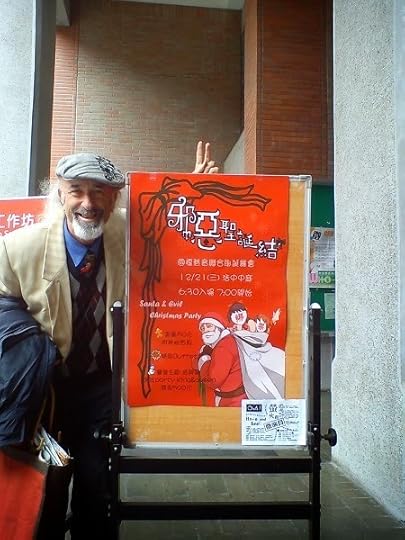 American climate activist Dan Bloom
American climate activist Dan Bloom visiting a local university in Taiwan to
do some research on climate change issuesMy blog post about Climate Fiction, a "hot new genre" (here) led me to "virtually" meet Dan Bloom, the journalist and “green” activist who coined the term "Cli Fi". I was very happy to meet him, he's a fascinating and somewhat explosive person, a Tufts graduate who's worked in Alaska, Japan and Taiwan (where he now lives). And he's agreed to answer a few of my questions here.
Claude: Dan, you coined the term Climate Fiction, cli-fi for short, back in 2008. When did the term start to catch on?
Dan: The term was modelled after sci-fi, of course, and at first it didn’t really catch on, not until 2013 when NPR did the first big media story on the cli-fi genre (see here ).
Claude: I took a look at that article, it has a great title “So Hot Right Now: Has Climate Change Created a New Literary genre?” and a striking introduction mentioning a best-selling cli-fi novel, as you can see on this screen shot:

Dan: Yes, and now the term is fast becoming a buzzword in the media, culminating in the recent article in the New York Times about using cli-fi in the classrooms to teach American students how to handle the challenge of global warming (see here ).
Claude: Yes, that’s how my attention was drawn to it, from reading it in the New York Times. I noticed the story was picked up by others as well, including Sadie Mason-Smith on the Melville House website (here). And now, according to the UN's IPCC latest report on Climate Change, climate warming is fast getting worse because too many countries have dragged their feet for too many years (see here ) So there’s a definite need for Climate Change activism! I'd like to find out how the idea of "cli fi" ever occurred to you. Why did you coin the term?
Dan: I have been an independent deep-green climate activist since 2006 when the big earth-shaking IPCC report on climate came out and it was that IPCC report and the accompanying news media articles about the report that woke me up.
Claude: So your concern for global warming and its consequences is relatively new?
Dan: Yes. Before then, I was not thinking very much about climate issues. But I woke up in 2006. Not being a scientist, there was not much I could do to join the debate about climate change and global warming.
Claude: What was your “wake-up” moment?
Dan: A 2008 blog post by New York Times science reporter Andrew C. Revkin on his "Dot Earth" sustainability blog. That’s what did it. He mentioned how artists and novelists can use "the arts" to communicate climate issues to a broad public. That made me think what I could do, if anything, to add to that concept of art and literature as tools of communication.
Claude: So, concretely, what was your next step?
 Dan: One day while I was doing some PR for a climate-themed book by Jim Laughter, a Tulsa, Oklahoma author, for his novel titled Polar City Red set in Alaska in 2075 (the book came out in 2012, see here ) I hit on the cli fi term I had coined in 2008 to describe Hollywood movies focused on major environmental change like The Day After Tomorrow. I decided to inject the cli fi term as part of my press release about Jim Laughter's Alaska novel. So I sent out some press releases to book reviewers and I called his novel a ''cli fi thriller'' and slowly the term took on a life of its own. A few newspapers and blogs used the term in talking about Jim's novel, but nothing more, although one newspaper in North America reviewed it.
Dan: One day while I was doing some PR for a climate-themed book by Jim Laughter, a Tulsa, Oklahoma author, for his novel titled Polar City Red set in Alaska in 2075 (the book came out in 2012, see here ) I hit on the cli fi term I had coined in 2008 to describe Hollywood movies focused on major environmental change like The Day After Tomorrow. I decided to inject the cli fi term as part of my press release about Jim Laughter's Alaska novel. So I sent out some press releases to book reviewers and I called his novel a ''cli fi thriller'' and slowly the term took on a life of its own. A few newspapers and blogs used the term in talking about Jim's novel, but nothing more, although one newspaper in North America reviewed it. Claude: Yes, a major newspaper too! I noticed that the New York Times has described his book as “a thought experiment that might prod people out of their comfort zone on climate.”
Dan: Right. And, in spite of relatively slow sales for that book, I didn't give up and tried to keep the cli fi term alive with many blog posts and by leaving a large digital footprint on the internet, so that if any reporter googled the cli fi term, hundreds of items would show up in the Google search list.
Claude: And on Wikipedia. You can read about it here. But what was the turning point?
Dan: It came in late 2012, when a climate scientist in Atlanta, Georgia named Judith Curry got interested. She is not only a dedicated scientist with a keen interest in the science of climate change but also a woman with a deep appreciation of the humanities and the arts. So she did a big post on her ''CLIMATE ETC'' blog; it’s a very popular blog and she gets 300 to 500 comments on each post – the post about cli-fi novels she titled simply "Cli fi" (see here)
 Dr. Judith CurryClaude: She opens her post by noting that cli-fi is a “fledgling new genre in literature”. Then she immediately mentions Michael Crichton’s blockbuster
State of Fear
, a 2004 techno thriller against the backdrop of global warming. However it got panned apparently because of gross scientific errors. She argues that a climate scientist could however pen such a techno thriller without losing his reputation and she cites Rex Fleming .
Dr. Judith CurryClaude: She opens her post by noting that cli-fi is a “fledgling new genre in literature”. Then she immediately mentions Michael Crichton’s blockbuster
State of Fear
, a 2004 techno thriller against the backdrop of global warming. However it got panned apparently because of gross scientific errors. She argues that a climate scientist could however pen such a techno thriller without losing his reputation and she cites Rex Fleming . Dan: Cli fi as a genre was certainly ‘fledgling’ back in December 2012. But Dr Curry herself changed that. She makes a list of about 20 or so cli fi novels, including big names like Clive Cussler, Ian McEwan and Barbara Kingsolver. And she included Jim Laughter's Polar City Red and used my press release term of calling it a "cli fi thriller". That led four months later to NPR interviewing Dr Curry for its CLI FI radio program announcing that a new literary genre had arrived. I had sent dozens of press releases to the NPR book department email address about the cli fi concept, but the station never replied to any of my appeals for an interview or a radio show about the new genre.
Claude: Par for the course, I suppose that was rather discouraging…Of course, Dr. Curry is a big shot at the Georgia Institute of Technology.
Dan: She heads the School of Earth and Atmospheric Sciences since 2002.
Claude: Isn’t she also a rather controversial figure? There is this interesting article in the Scientific American that calls her a “climate heretic” who has “turned on her colleagues”. But that article was written in 2010 and is now probably reflecting an outdated position in the American scientific community. I rather like her position on the latest Climate Change report from the UN: she welcomes the idea of putting the Climate Change discussion behind us and focusing on the needed survival strategies rather than pursue mitigation or curbing measures… What is your take on this?
Dan: I read Dr Curry's blog posts regularly and keep in touch with her by email from time to time, too. I deeply respect and admire the kind of scientist (and humanist) she is. She's one of my teachers now, too.The world needs more scientists like her, who are not afraid to speak their minds and even join the debate from different sides of the table. And I am so glad she blogged about cli fi novels back in December 2012. Her post led to all this today.
Claude: You mean the interest shown by NPR?
Dan: Yes. So imagine my surprise one day in April 2013 when I see via my daily Google search for cli fi news that NPR did the story! I immediately set about doing all I could as a PR operative and a climate activist and a literary theorist to push the cli fi meme uphill, using the NPR link as the wake-up alarm. I wrote to the Guardian and asked if they could do a cli fi story for British readers. They did. I wrote to the Financial Times in the UK and asked my contacts there if they could do a cli fi story, and they did. Alison Flood, the Guardian's book critic, did a blog post on "why cli-fi is here to stay".
Claude: Wow, I’m impressed!
Dan: At first most media never responded to me, or even answered my email pitches. But they did line up, one by one, to add to the ''cli fi genre is rising'' chorus, from Britain to Australia. I kept up the PR blitz, contacting every media outlet I could. The New Yorker magazine followed the Brits, as did Dissent magazine last summer. There was something in the air I think, but my PR campaign was crucial. I then spent time lobbying the New York Times to report the cli fi news, and I contacted 12 reporters and met up with 6 months of rejections and emails that read "sorry not interested." But in January 2014 I found one Times reporter I knew from earlier contacts ten years ago and I emailed him. And three months later his New York Times article came out worldwide not just in the U.S print edition and on the newspaper's popular website, but also via the New York Times News Service which syndicated the article to over 400 newspapers worldwide, from Italy to France to Japan to Sweden.
Claude: So the New York Times article, the one I noticed, was a major turning point.
Dan: It was. Now I am focusing my media contacts on the Associated Press and Reuters News Service for wire stories about the cli-fi genre. And Nicholas Kristof, the New York Times columnist who has a keen interest in climate change issues, told me he will write a Sunday column soon about his take on the power of cli-fi literature to serve as a wake-up call. So things are happening.
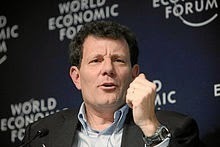 Nicholas KristofClaude: They sure are! I’m looking forward to Kristof’s piece, I think he’s a remarkable columnist and I totally agree with the concept that climate fiction can serve as a much needed wake-up call. We need to go beyond sterile discussions about who or what is responsible for global warming and do something about it because one thing’s certain: it’s happening! Is that why the idea of cli-fi occurred to you?
Nicholas KristofClaude: They sure are! I’m looking forward to Kristof’s piece, I think he’s a remarkable columnist and I totally agree with the concept that climate fiction can serve as a much needed wake-up call. We need to go beyond sterile discussions about who or what is responsible for global warming and do something about it because one thing’s certain: it’s happening! Is that why the idea of cli-fi occurred to you?Dan: Yes, as a climate activist but also as a literary activist…My major at Tufts University in the 1960s was French literature and I spent a year in Paris in 1969 absorbing the culture and drinking the coffee -- I felt that a new literary term for climate-themed novels might help serve as a wake-up call for the future humankind faces now. Besides, I've always loved words and word games and crossword puzzles and sci-fi. I grew up with sci-fi novels in the 1950s and 1960s. I am a big sci-fi fan. So one day, my imagination just jumped over the fence and told to make a new word and call it cli-fi and see what happens. I like to see what happens. So I did it.
Claude: So are you a writer in pectore?
Dan: No, I am not a novelist or a short story writer or a screenplay scriptwriter. I don't have those kind of writerly skills. I am just a climate activist, first, and a lifelong reader of novels, second.
Claude: I gather that Margaret Atwood was an early supporter, though she calls her own novels “speculative fiction” rather than cli-fi -- while at the same time fully supporting your creation of the cli fi genre for whoever wants to work in it.
 Margaret Atwood (Author page on Amazon)Dan: Exactly. Margaret Atwood has written three op-eds applauding the creation of the new genre that has been dubbed cli fi, one was published in the Canada Living magazine, one was published in the Huffington Post and another was published in the Financial Times recently in London. And she has often tweeted and retweeted cli fi news links to her 450,000 followers!
Margaret Atwood (Author page on Amazon)Dan: Exactly. Margaret Atwood has written three op-eds applauding the creation of the new genre that has been dubbed cli fi, one was published in the Canada Living magazine, one was published in the Huffington Post and another was published in the Financial Times recently in London. And she has often tweeted and retweeted cli fi news links to her 450,000 followers! Claude: That’s a lot of followers on Twitter!
Dan: So yes, Ms Atwood has been instrumental in helping to popularize the cli-fi genre, come what may. I consider her my teacher, although we have never met. My other two teachers in the cli fi project are James Lovelock, whose ideas about the Earth being a kind of Gaia goddess that needs to be respected and protected or it's curtains for the human race, and Andrew Revkin who runs the Dot Earth blog at the New York Times and which I have followed since its inception.
Claude: Okay, now let’s get down to the nitty-gritty. What is your definition of Climate Fiction?
Dan: First of all, I want to make it clear: the term I created is "cli-fi" which stands for climate fiction, of course, CLImate FIction with caps and lowercase letters, and I never use the term "climate fiction." My PR work is not about "climate fiction" but about "cli-fi."
Claude: I hyphenate the term by analogy with sci-fi, but I notice you don’t…
Dan: So I want to use the term "cli fi" only in this interview and I also only use cli fi in my press releases. Why? As a lifelong journalist and PR guy, I know the power of headline buzzwords to serve as signposts along the road. So cli fi is a signpost and a wake-up call. The term "climate fiction" has been used for a long time, and I never coined that term. I just took it and tried to transform the longer version into a kind of code word and I thought of calling it "cli fi." So let's just talk about cli fi and leave "climate fiction" for scholars and professors to discuss. The New York Times article about cli fi just mentioned the term once in the entire 1000-word story, and not in the headline at all.
Claude: I put it in the title of my blog!
Dan: Good! I was hoping for a headline mention of cli fi in the NYT, but in the PR business one cannot control how headlines are written or even how news articles are written. But the Times article was very important and for one special reason: cli fi has now been mentioned in the newspaper of record, The New York Times. That's a first. This is the beginning. There is no stopping the rise of cli fi novels now.
Claude: What hopes do you have for the genre? What do you expect to achieve through it?
Dan: My hope is that cli fi will serve to bring together novelists and editors and literary agents and publishers -- and readers! -- as we explore the role of novelists in the ongoing debates over climate change and global warming. My hope is that the news media will start reviewing cli fi novels as cli fi novels, and stop calling them science fiction novels.
Claude: You don’t consider cli-fi as a subgenre of science fiction?
Dan: As I see things now, after several years of working on this project and getting a lot of feedback from readers and writers in both the sci-fi community and the growing cli fi community, cli fi is not a subgenre of sci-fi but a genre of its own. And sci-fi novels can also focus on climate change and still be classified as sci-fi novels, if that is how the novelists themselves want it and how literary critics see it. But at the same time, I now see cli fi as a separate genre that has attracted its own community of writers and readers worldwide. And sci-fi and cli fi are not competing genres at all; they complement each other, and they are, in a way, sister genres. I love sci-fi, and always have.
Claude: Me too. I consider Aldous Huxley and Orwell among the greatest writers of the 20th century...
Dan: Now I am trying to popularize cli fi, too. I believe we are on the same page, sci-fi writers and cli fi writers. But one thing needs to be pointed out: While cli fi is usually filled with the moral implications of climate change issues, sci-fi is usually filled with the intention of exploring the possibilities of science and its relationship to humankind. So that is where cli fi and sci-fi go in different directions, and both genres are valid and useful.
Claude: Yes, both are useful and I love both! But what sort of future do you see for cli fi?
 Dan: My hope is that a modern Nevil Shute will arise, male or female, in any country in any language, to write and publish a climate-themed cli fi novel with the same power as Shute's 1957 novel
On The Beach
which served as a wake-up call about nuclear war and nuclear winter. And the movie was important, too.
Dan: My hope is that a modern Nevil Shute will arise, male or female, in any country in any language, to write and publish a climate-themed cli fi novel with the same power as Shute's 1957 novel
On The Beach
which served as a wake-up call about nuclear war and nuclear winter. And the movie was important, too. Claude: The Next Big Novel that will shake society should be in “cli fi”!
Dan: Right! So I am looking for the Nevil Shute of cli fi. And to do this, I am quietly setting up what I call the international Nevil Shute Climate-Themed Novel Award to be first awarded in 2020 for the best cli fi novel in the previous ten years and to repeat the award every ten years internationally and awarding a prize of $1 million to the winner.
Claude: Hey, I’m going to candidate my soon-to-be published Forever Young! Though I must admit that cli fi is only one element, there are other things in it like the demographic explosion and growing income inequality…
Dan: Why not? You and many more writers, that’s what I’d like to see. I am now in the fundraising process of this new project, an offshoot of my cli fi PR work. I am looking for sponsors and a committee of judges to honor these kinds of cli fi novels. And I hope to see the "Nevils" -- as I am dubbing the awards -- keep going for 100 years, awarded every ten years for a total of ten times. And if the awards committee in 2120 wants to keep the awards going for another 100 years, I will nod yes from the grave. Literature matters. Words matter. Novels and movies made from novels can wake people up. The world is still asleep. We are facing the potential end of the human race. Wake up, world!
Claude: An impressive project! What else have you got up your sleeve?
Dan: Another thing I am working on is this: I am trying to find a reporter in New York or London who covers the book industry to find out if they can do a print newspaper or online story about how literary agents and everyone in the publishing industry view the rise of cli fi as a new genre and if they plan to use the term in future book titles or book covers. Raising the media profile worldwide of the cli fi genre is now my life's work. And then I die. This is my way of giving back to a world that has given me so much. I go out every day to my PR office not to make money but to make a difference. I was educated to think of life this way, and now in my mid-60s, I have found a way to express myself on my own terms. I am not doing this cli fi work for myself or to benefit from it in any way. I do not want money or fame. I like to work quietly in the background and I find the internet a very pleasant place to hang my sign: "Dan Bloom, climate activist - no fees charged."
Claude: Dan, that’s wonderful and I wish you every possible success in this most worthwhile cause. Thank you so much for joining me here and telling us about your dreams and your plans.
I look forward to comments from my blog readers: has anyone read a cli fi novel recently? If you have, or know something about the genre that has not been covered here, please share!
Dan Bloom BIO:
Dan Bloom grew up in the Boston area, attended Tufts University where he majored in modern literature and minored in French, and has spent his adult life working as a newspaper reporter, editor and blogger in Alaska, Japan and Taiwan. He is now dedicating his life to promoting the new
literary genre of cli fi and working on it 24/7 from his "office" in a small internet cafe in southern Taiwan (as Dan does not own a computer and never has, describing himself as a Neo-Luddite.)
For readers or media people worldwide who want to contact him, his email at the internet cafe is danbloom@gmail.com and he welcomes all inquiries and in all languages. For more information, visit Dan Bloom’s bog, CLI FI CENTRAL, click here










Published on April 16, 2014 23:41
April 13, 2014
Climate Fiction: A Hot New Genre?
 Is climate fiction really a hot new genre (no pun intended)?
Is climate fiction really a hot new genre (no pun intended)?Something remarkable has happened. When American colleges start to use climate fiction to teach how to prepare for the coming climate crisis, expect writers to sit up and listen - especially science fiction writers. The New York Times recently reported on it (see here) saying classes focus on a "heavy dose of the mushrooming subgenre of speculative fiction known as climate fiction, or cli-fi, novels like Odds Against Tomorrow, by Nathaniel Rich, and Solar, by Ian McEwan."
Further down in the article, more cli-fi books are mentioned, among them Barbara Kingsolver's Flight Behavior, Daniel Kramb's From Here, Hamish MacDonald's Finitude, Paolo Bacigalupi's The Windup Girl, Saci Lloyd's The Carbon Diaries 2015 and more recently The Carbon Diaries 2017 (a British YA book).
Wow! I sat up and listened since my soon to be released Forever Young looked like it might fit the genre.
Checking around on the Net, I visited Wikipedia's definition (see here) and discovered that the earliest climate fiction book was The Drowned World published back in 1962 by J.G. Ballard (though it wasn't Climate Change in this case but solar warming). Here's the first edition (nice cover!):
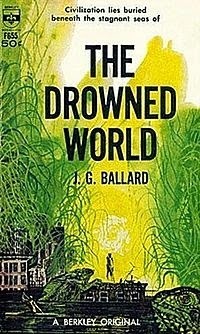
I gathered a slew of interesting articles (see below) and checked Goodreads. I found a whole page there dedicated to so-called "popular climate fiction books" (39 titles so far):

Take note: climate fiction has attracted big best-selling writers like Ian McEwan, Margaret Atwood (who famously tweeted about it), Clive Cussler and Barbara Kingsolver. They have all jumped into the subgenre and some as early as 2009 (in Atwood's case).
The blogosphere is awash with posts (see below) and there's one book selling website set up by a British Columbia "micropress", the Moon Willow Press, with a green conscience; take a look at their home page:

This site gives an interesting definition of climate fiction:
"a genre of literature, film and other media that involves climate change fiction, which may be speculative, literary or science fiction".
So here we are moving away from the idea that it may be a "subgenre" of science fiction. It is also described as "bendable...not necessarily set in the future nor always apocalyptic", and Barbara Kinsolver's Flight Behavior is given as an example (the setting for this present-day story is the explosive invasion of Monarch butterflies into the Appalachian Mountains).
There is at least one blog fully dedicated to climate fiction set up by Dan Bloom, a journalist and writer who invented the term back in 2007 (on his blog and in an article in Vice Magazine) - the term was picked up again by reporter Scott Thill in 2010 in Wired.
Here's the homepage of Dan Bloom's Cli Fi Central blog (to visit, click here):
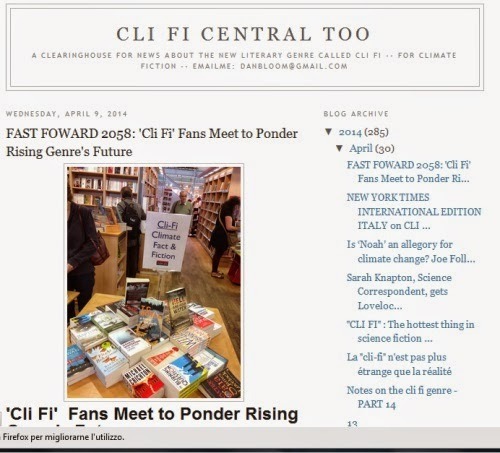
The news reported on that page is of some 6,000 "cli fi" fans meeting in...2058 to discuss climate change! Yes, a little bit of irony doesn't hurt (but only 6,000? That's a depressingly small number...)
Climate fiction is still very new and evolving. Dan Bloom acknowledges this and last summer summed it up neatly in this article about the origins of cli-fi and where it's going, see here. He notes that cli-fi has recently drawn two stars who met and talked about it at the 2013 Kingston WritersFest: Margaret Atwood on her way to a likely Nobel Prize in Literature and Nathaniel Rich, "a freshman Manhattan newcomer" who's fast spreading the word about "climapocalypse" to his (30's) generation.
The news about climate fiction took off when the National Public Radio (NPR) and the Christian Science Monitor used the term - the story then rebounded on the UK Guardian in May 2013 (see Rodge Glass' article here), and it was picked up by newspaper columnists in Turkey, Sweden, Lithuania, Spain and Italy. Yes, going global!
The Guardian article got 139 comments, with most approving the birth of a new genre and some objecting that a new term was not needed. The best comment in my view comes from someone calling himself "Keyserling":
"It's apparent that "cli-fi" is nothing new, we just have a new buzz-word to describe it. I don't like the term (my mind associates it with "clitoris fiction", of the appalling Fifty Shades type). But we do need a new genre.
As the world knowingly embraces climate destruction, and we reap the whirlwind, islands will be lost, coastlines, then streets and cities flooded. Continents may perhaps become lethal or altogether uninhabitable, and eventually, a much reduced mankind may be reduced to living in polar colonies, or on space platforms orbiting our once abundant planet.
As that happens - like a global, inevitable, unstoppable, slow motion car crash - authors will more fully focus on the actual decay and destruction around them, and their observational fiction may not neatly slot into the overcrowded dystopian / apocalyptic / post-apocalyptic genres, alongside Planet of the Apes, Level 7, or The Day of the Triffids, et al.
So yeah, a new genre, to reflect new times. O brave new world!"
And another writer, Joe Follansbee, has come up with "6 rules" for writing climate fiction on his blog; briefly put, climate change has to be the "driving narrative" and it's not to be confused with a weather event (say a tornado) which is short-term. We are speaking here of long-term climate trends that affect humanity's future.
But the latest United Nations report on climate change has put a new twist on it: it's no longer an "exceptional event" that would demand it be stopped but something that humanity has to learn to live with. See this illuminating article in The Atlantic. The idea is that all is not lost, we can adapt to a warming world.
That seems to put paid to Climate Change as a primary source of high suspense for climate fiction!
I would argue that the demographic explosion, the overwhelming trend towards urbanization and growing socioeconomic inequality are beginning to look like better candidates for suspense - or at least they look like very credible sources of social tension and recurring human-created disasters (e.g. displacement and extinction of species, recurring local wars, smog-caused health emergencies, refugee crises and population displacements, spikes in food prices leading to famines etc etc).
Add to the mix natural disasters like floods, earthquakes or tsunamis, and an already fragilized socio-political situation could easily get out of hand.
That is a much more likely future than the one posited by Climate Change alone. That is the future I see in my upcoming book, Forever Young - set 200 years from now. Why 200 years? Because I don't believe things will come to a head all that soon. People always cry foul and use biblical language to warn humanity of impending doom - a doom that never comes on schedule. Which is why 200 years seemed like a reasonable lapse of time...
And Climate Fiction as a subgenre? I'm not sure it's headed anywhere...What is very striking is that as a subgenre, it hasn't developed a recognizable style of book covers. Take a look above at the Goodreads bookshelf. Or take a look at the book covers you find on the Cli-Fi Books site, here are a couple, chosen at random:
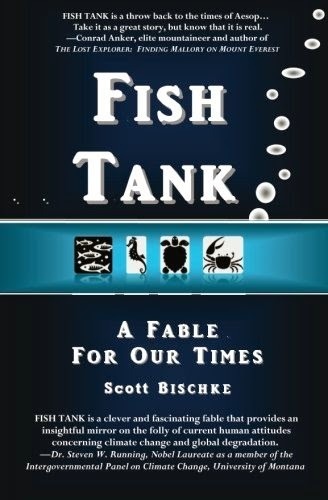
Clara Hume's novel takes the reader "through apocalytpic American after climate change and other ecological disasters have greatly altered the planet":

But you wouldn't guess that from the cover, would you?
Do you see any pattern in the design of these covers? Personally, I don't. They're nice covers, often with a retro charm (like Clara Hume's), but there is surprisingly little or no reference to a doomed or threatening future, which is the least you would expect.
What do you think? I tend to believe that climate fiction might possibly merge into the "hard science fiction" genre (see here) which is based on scientific accuracy, i.e. on the best informed guess about where we are headed...At least "hard" sci fi covers have a distinct sci-fi flavor, see here for an early book in the genre:
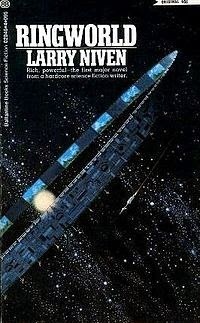 First edition (published in 1970)But the latest best-seller in the genre, Hugh Howey's WOOL, certainly sports a rather bizarre cover that is a radical departure of the "classic" science fiction genre:
First edition (published in 1970)But the latest best-seller in the genre, Hugh Howey's WOOL, certainly sports a rather bizarre cover that is a radical departure of the "classic" science fiction genre: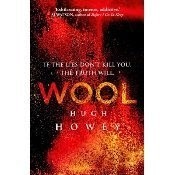
So it looks like the reverse might be happening: "hard" science fiction is merging into climate fiction...
Perhaps this is not as far-fetched as it sounds. Some people are convinced that climate change is "the hottest thing in science fiction", as Dave Burdick put it (see here, on Grist) and he reports the interesting observation made by Csicery-Ronay, an English professor at DePauw University in Indiana and co-editor of the journal Science Fiction Studies: "Cli-fi is getting some interest from folks who are not necessarily interested in science fiction."
I'm very happy to hear that. Because climate fiction is not a silly fantasy. Because the whole point of it is to make us think seriously about the future of humanity and where we're going...
One thing's for sure: climate fiction sells as it attracts more and more people beyond strict science fiction fans. An example? Knopf's recent acquisition of Paolo Bacigalupi's new novel The Water Knife, to be released next year, see here (before that he was with a small press). Following on his success with the Windup Girl (200,000 copies sold), the editor at Knopf is convince his new novel is set to attract a "cross over audience" beyond Bacigalupi's "core readers".
Hey, are you ready for climate fiction? I know I am!
Related articles:
 New York Times embraces 'mushrooming' genre of cli-fi
New York Times embraces 'mushrooming' genre of cli-fi
 OP-ED: "Cli-Fi" May Be No Stranger Than Reality
OP-ED: "Cli-Fi" May Be No Stranger Than Reality
 Six rules for writing climate fiction
Six rules for writing climate fiction
 The Importance of Setting in Science Fiction
The Importance of Setting in Science Fiction
 Using the arts to teach how to prepare for climate crisis.
Using the arts to teach how to prepare for climate crisis.
 New York Times Rides Growing Wave of Climate Fiction (Guest Blog)
New York Times Rides Growing Wave of Climate Fiction (Guest Blog) 









Published on April 13, 2014 09:16
April 10, 2014
When a Novelist Defies All Conventions: "The Blazing World"
 Siri Hustvetd's latest novel, The Blazing World, defies all conventions about novel writing. Its format is quite literally like no other novel ever written (that I know of), which is why I bought it and read it. I love it when someone has the courage to break down all the rules. It's wonderful to find yourself in unknown, undiscovered territory. Very refreshing.
Siri Hustvetd's latest novel, The Blazing World, defies all conventions about novel writing. Its format is quite literally like no other novel ever written (that I know of), which is why I bought it and read it. I love it when someone has the courage to break down all the rules. It's wonderful to find yourself in unknown, undiscovered territory. Very refreshing.The Blazing World is a novel different in both form and structure. To begin with, it presents itself like non-fiction. It pretends to be the work of an "editor" who has put together a biography/portrait of a recently deceased contempory artist, Harriet Burden. The (fictitious) editor uses, as is always done in this kind of work, testimonials from art critics, family and friends and extracts from the artist's personal diary.
This format enables the author to tell Harriet Burden's story from various points of views. I was struck by the novelist's remarkable ability to change "voice" and convincingly draw a highly sensitive portrait, as Harriet is differently perceived by the people who knew her.
From the start, you are told that she has recently shaken the New York art scene, putting on highly successful shows using male artists as "screens" or pseudonyms for her work. She has used three artists, two unknowns and one well-known, for this bizarre project that she has called "maskings" - a project intended to "prove" that one's perception of the art one sees is governed by one's knowledge of the artist. In particular, she wants to show that art made by a man sells better than art made by a woman; that there is a diffuse gender bias in the art world. Harriet Burden's art had never attained prominence when it was shown under her own name but now it suddenly achieves success simply because it is seen by the public as the work of a man.
Harriet Burden's plans go awry when Rune, the third artist who is a celebrity in his own right, refuses to reveal that she is the author of the show. He takes on all the critical acclaim, leaving her in the dirt. She smarts from the injustice and as a reader, you smart along with her - which shows how effective the author's writing is.
No spoilers and I won't give out more of the plot, except to say that the story is practically known from the start. That's another peculiarity of this novel: there is next to no suspense. You know from the first page that Harriet is dead and you know very soon what happens to the man who betrayed her (the third artist in her "maskings" project).
So why do you keep reading? Because of the superb writing of course, and because of something else too. Questions are asked that you never thought of asking. The book is filled with gems - insights into life and art and the human condition. The sort of thing that gives you arresting moments of self-revelation and a deeper understanding of the world around you.
Here's a few quotes to give you an idea:
"...it is not what is said that makes us who we are. More often, it is what remains unspoken" (this came up in connection with Harriet's upbringing and difficult relationship with her father); "It is my time, and I will not let them take it away from me. The Greeks knew that the mask in the theater was not a disguise but a means of revelation. And now that I have started, I can feel the winds behind me...(Harriet, commenting on her "maskings" project);"Mostly, the art business has been about men. And when it has been about women, it has often been about correcting past oversights. It is interesting that not all, but many women were celebrated only when their days as desirable sexual objects had passed.""Human beings are the only animals who kill for ideas.""Celebrity is life in the third person."I actually underlined the book 51 times. That (for me) is something of a record and a good indication of how much I enjoyed it (lucky I read the digital version, if it had been the printed one, it would have looked very messy indeed).
Is there anything wrong with this novel?
Yes, for anyone looking for suspense. There is none.
And yes, there's a little too much about art, perception and gender. To a large extent - you're warned! - this is a feminist book. Harriet Burden makes a lot of allusions to philosophers in her diaries, allusions that would get lost or misunderstood without (very academic) footnotes. So you find yourself reading the footnotes. Actually, there's a certain, perverse pleasure in reading them but at times, it does become a little too much. And perhaps, while the footnotes make sense in a book that pretends to be non-fiction, they certainly detract from the pleasure of reading the book as a novel - in principle, a form that never has any footnotes (unless it's a classic for school use).
My conclusion? It is well worth reading and I highly recommend it. But it really isn't a novel as such - more an intellectual joy ride. I doubt that this book will spawn off many more books of the same type. The format is enticing but not easy to follow or reproduce.
However this total departure from the novel form is interesting inasmuch it seems to indicate that we may be reaching a certain degree of fatigue with the "standard" novel and the three act structure. We live in an age of experimentation. That is certainly what I did in Luna Rising (in Book One, I combined novel and play writing). Many books lately are "cross-genre" and even "serialized" (broken up in bits like a TV series, making them easier to consume in our fast-paced, attention-squandering digital age). And of course we have fictionalized biographies and documentaries.
So why not fictionalized non-fiction?
 For more info, visit her websiteFor those curious about the author: she is the wife of Paul Auster and author of five internationally acclaimed novels, The Sorrows of an American, What I Loved, The Enchantment of Lily Dahl, The Blindfold, and The Summer Without Men, as well as nonfiction, notably Living, Thinking, Looking, a compendium of 32 essays about philosophy, memory and imagination. The same questions that animate The Blazing World recur here: How do we see, remember, and feel? How do we interact with other people? What does it mean to sleep, dream, and speak? What is "the self"?
For more info, visit her websiteFor those curious about the author: she is the wife of Paul Auster and author of five internationally acclaimed novels, The Sorrows of an American, What I Loved, The Enchantment of Lily Dahl, The Blindfold, and The Summer Without Men, as well as nonfiction, notably Living, Thinking, Looking, a compendium of 32 essays about philosophy, memory and imagination. The same questions that animate The Blazing World recur here: How do we see, remember, and feel? How do we interact with other people? What does it mean to sleep, dream, and speak? What is "the self"? The Blazing World, just published (March 13, 2014) is available on Amazon here and Living, Thinking, Looking can be found here. Note that The Blazing World is expressedly called after Margaret Cavendish's own magnum opus (available here - yes, titles cannot be copyrighted!)
Margaret Cavendish was a 17th century aristocrat and a brilliant scientist and philosopher who suffered from that fact that, being a woman, she wasn't taken seriously by anyone in her own time, though she corresponded with Descartes and Hobbes. Siri Hustvetd's main character, Harriet Burden, considers Cavendish as her idol and role model.
 Margaret Cavendish, Duchess of Newcastle (1623-1673)
Margaret Cavendish, Duchess of Newcastle (1623-1673)Blazing World was reviewed by the New York Times, see here, as well as in the following articles in the British press:
 The Blazing World by Siri Hustvedt, book review: Portrait of over-shadowed female artist
The Blazing World by Siri Hustvedt, book review: Portrait of over-shadowed female artist
 The Blazing World by Siri Hustvedt, review
The Blazing World by Siri Hustvedt, review
 The Blazing World by Siri Hustvedt - review
The Blazing World by Siri Hustvedt - review










Published on April 10, 2014 08:44
April 7, 2014
Author Bob Rector's Interview of C.N.
 Reblogged from author Bob Rector's blog, see here. He's just launching a round of interviews of authors - so keep an eye open on his blog, more interesting interviews are sure to come!
Reblogged from author Bob Rector's blog, see here. He's just launching a round of interviews of authors - so keep an eye open on his blog, more interesting interviews are sure to come!I'm very honored to have drawn his interest. He is a remarkably talented writer himself, the author of Letters from the Front, a show that became known as the World's Most Decorated Play and that entertained America's troops around the world for fifteen years. Most recently, he has released a smashing novel of romance and suspense, Unthinkable Consequences (see here) that is climbing the Amazon ranks at a fast pace and has already garnered 19 reviews, all of them 5 stars and well-deserved too!
For more about Bob Rector, click here. And here's the interview, with lots of arresting questions:
April 6, 2014
MY INTERVIEW WITH MULTI-TALENTED CLAUDE NOUGAT
 It is with great pleasure that I introduce to you the very talented author/artist Claude Nougat. Not only is she a gifted storyteller, she also provided invaluable editing advice to me while I was in final preparation of my manuscript for Unthinkable Consequences.
It is with great pleasure that I introduce to you the very talented author/artist Claude Nougat. Not only is she a gifted storyteller, she also provided invaluable editing advice to me while I was in final preparation of my manuscript for Unthinkable Consequences.
Claude you are an accomplished author with several books in release, but before we start discussing your word-craft, tell us a little about your background.
 I guess you could say I’m a world citizen, I really don’t have roots anywhere. Born in Belgium, raised in Sweden, Egypt, Russia, France, Colombia and finally reaching the US when I was 17 – picking up on the way many languages and forgetting them in turn. What’s left is French, Italian, Spanish and of course English that I learned attending classes at the American Embassy in Moscow. My formative years as an intellectual took place in America, at Columbia U. I graduated in economics not because I particularly liked the subject but because my father felt that studying anything else would be a “waste of time” (what I really wanted to study was paleontology, I love old bones…) Once out of school, I travelled the world over for the United Nations, giving management advice to aid projects in difficulty, a fantastic job. It put me in touch with so many different people – a very enriching and full experience that lasted 25 years till I retired in 2003.
I guess you could say I’m a world citizen, I really don’t have roots anywhere. Born in Belgium, raised in Sweden, Egypt, Russia, France, Colombia and finally reaching the US when I was 17 – picking up on the way many languages and forgetting them in turn. What’s left is French, Italian, Spanish and of course English that I learned attending classes at the American Embassy in Moscow. My formative years as an intellectual took place in America, at Columbia U. I graduated in economics not because I particularly liked the subject but because my father felt that studying anything else would be a “waste of time” (what I really wanted to study was paleontology, I love old bones…) Once out of school, I travelled the world over for the United Nations, giving management advice to aid projects in difficulty, a fantastic job. It put me in touch with so many different people – a very enriching and full experience that lasted 25 years till I retired in 2003. I happen to know that you are also a very talented painter. Do you find that it compliments your skills as a writer? If so, how?
Painting and writing seem to call on diametrically opposed segments of the brain: the mode of concentration is totally different – painting is more intuitive, it sort of “happens” on the blank canvas. You could argue that a book also happens on a blank page, but it is a long haul, not like a painting that can be done in a few hours. A book can take years in the making – my first one (now out as “Luna Rising”, a Sicilian family saga) took 30 years in the making, from the first moment I thought of it (when I walked into a dusty men’s club in Sicily full of old men playing backgammon – they all looked like ghosts) to its most recent incarnation (now out in a brand new edition). A painting only takes a few days, in that sense, a painting is more like a short story or a poem…
Two of your works that I truly enjoyed are Crimson Clouds and Forever Young. Give us a brief description of each.
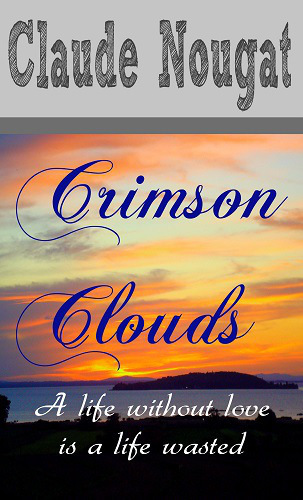 So happy you enjoyed them! “Crimson Clouds” is about the anxieties of restarting one’s life after retirement. Robert, the protagonist, in his early 60s, a brilliant manager, he’s still young and attractive and has a lovely and much younger wife who’s carved out her own success as a dealer of contemporary art. But when he decides to renew with a childhood dream of being an artist and produces paintings that are dreadfully academic (a little like my own!), his wife is horrified. They fight over art but what is at stake is their marriage and they separate. He goes to Italy, has some love affairs but his wife wants to save their marriage and comes back to him…
So happy you enjoyed them! “Crimson Clouds” is about the anxieties of restarting one’s life after retirement. Robert, the protagonist, in his early 60s, a brilliant manager, he’s still young and attractive and has a lovely and much younger wife who’s carved out her own success as a dealer of contemporary art. But when he decides to renew with a childhood dream of being an artist and produces paintings that are dreadfully academic (a little like my own!), his wife is horrified. They fight over art but what is at stake is their marriage and they separate. He goes to Italy, has some love affairs but his wife wants to save their marriage and comes back to him…“Forever Young” is set 200 years from now, when the Earth is dying and only the ultra rich, who can afford the costly and exclusive Age Prevention Program (APP), enjoy a perfect life in their gated communities, looking young till the day they drop dead. The book has three major characters, forming a love triangle: Jamie, a young investigative journalist from the World and US Post (the New York Times and Huffington Post rolled into one), his partner Lizzie, a professional golf player (she’s a descendent of the mythical Tiger Woods), and Alice, a beautiful Swiss nurse and an outsider: she yearns to join the APP and is in love with Jamie. There are two options to survive the extinction of life on Earth, both opened only to APP members: fly to another pristine planet similar to Earth or take refuge in Antarctica, the last virgin continent, and wait for the end to come, getting ready to re-settle the Earth afterwards. What will our threesome do?
Why do you write?
Tough question. I wouldn’t be me if I didn’t write!
What appeals to you most about crafting a story?
The suspense. Digging into another person’s head. Figuring what happens next. If I know ahead what’s going to happen in my story, I don’t feel like writing it at all. I’m my own first reader!
What writers have inspired or influenced you most and why?
All the classics, especially the Russians – I consider Gorki’s Dead Souls an absolute masterpiece, it’s got everything I love, the characters, the social comments, the way a light is thrown on society – much more effective than any sociological critical essay. The same can be said of Bulgakov’s The Master and Marguerite: literally insane fantasy and the most effective and devastating comment ever made about Communism and men’s tendency to fall into dictatorship. But I also like the French, Voltaire’s Candide and Camus’ novels for the same reason I like Gorki. Also the English, in particular the sci-fi masters, Aldous Huxley and Orwell though this is an area where there are lots of remarkable American writers too, from Frederik Pohl to Philip K. Dick and most recently, Hugh Howey. Actually, there are lots of amazing writers alive today from Penelope Lively to William Boyd, David Lodge, Louis Begley, Deborah Moggach, Tracy Chevalier, Siri Hustvedt…
If your writing was music, what would it sound like?
Good God, I have no idea! I guess, cool jazz…
What comes first for you, plot or character, and why?
Character, no question about it. The plot comes next, it develops out of a character’s strengths and weaknesses, yearnings and fears. The setting is often what challenges the characters and pushes them to their (internal) extremes but the challenges also come from relationships between characters.
Tell us a little about how you formulate your plots.
I don’t formulate them at all. I have a general idea and jump in. As I write, it all unfolds in front of my eyes like a film.
Talk a little about themes. At what point in your writing process do you address them?
Never. I don’t believe in writing with a theory in mind that you want to develop. The themes come naturally as a side-effect of the plot and characters. Forever Young really deals with major issues threatening life on earth but I hope that doesn’t show. The intention is to entertain, not teach or preach.
Tell us a little about how you create your characters.
Observation. People around me are warned! But most of all, I draw characters from my own inner self. Whatever looks logical for the character, given who he/she is, gets written down. The characters dictate the creation, not the other way around. I’m sure you know what I mean, because I can see that’s how you create your characters too.
Which characters have you created that are most vivid to you, or continue to reside in your heart?
The young man in Luna Rising, he is stuck in his life, he hates it and he’s trying to get out of it. Obstacles on his way, coming from the ghosts in his family, are so numerous that he is forced to become a hero or…die! Contrary to a lot of my readers who disliked Kay, the wife in Crimson Clouds, I actually love her. That’s why I rewrote Crimson Clouds (now the second edition of what was originally called A Hook in the Sky). I wanted to make it clear that for her, winning back her husband is a huge undertaking and he’s constantly cutting her down. So I added whole sections to the book giving her side of the story. And I also love Alice in Forever Young: she’s the outsider who should be in, but is constantly left out. But that doesn’t discourage her, she’s a brave, determined woman – at any rate, that’s how I think of her and painted her (at your behest!) and I’m thinking of using that portrait as a book cover…
 Portrait of Alice at dawn - oil on canvas by Claude (2014)
Portrait of Alice at dawn - oil on canvas by Claude (2014)You definitely should! Talk to us a little about writing good dialogue.
Bob, I think that’s where you’re the master! In any case, I follow your system: see the people talk, hear them talk (go in a trance if necessary!), take time to speak the dialogue out loud, and you’ll hear it when it’s too long or repetitive or useless. Then, there’s only one solution for it: cut, cut, cut!
I agree. For every line of dialogue that makes it on the page, I probably toss a dozen more. Do you have personal, social, or political convictions that worm their way into your writing? If so, give an example.
I suppose I do though I try very hard to not let them “worm” their way in. Yes, because they can be truly worms that punch holes in the plot. I am convinced that much of contemporary art is not good and I guess that worked its way into Crimson Clouds (mainly in the form of fights between Robert and the women in his life who are all contemporary art fans). Likewise, I’m convinced that income inequality is a major evil of our time and it’s become one of the premises of the brave new world you find in Forever Young.
What do you find most difficult about the craft of storytelling?
Avoid repetition. Not talk down to the reader. Realize that they’re bright and don’t need to be either lectured to or have to be told anything twice. So again, I cut!
Amen! Talk to us about your greatest “Ah-ha!” moment when you read over a passage or chapter and said, “Wow, that’s really good!”
Are you speaking of my own work? I don’t have such moments, ever, when it comes to my own writing! Other people’s writing, yes. Right now I’m into Siri Hustvedt The Blazing World and there are a fantastic succession of such awe-inspiring moments! Just to quote one (out of a dozen or more) when she describes the protagonist’s father: “Harriet’s father was physically awkward, prone to self-conscious pats of his daughter’s arm or quick, hard hugs that were more like speeding collisions than expressions of affection…He liked to expound to us on philosophy…He believed in tolerance and academic freedom…But it is not what is said that makes us who we are. More often it is what remains unspoken.” That last sentence is fantastic!
Many writers create different working environments or conditions that help them focus on the job at hand. Tell us about yours.
Nope, sorry to disappoint. No special environment. I work wherever and whenever I can, in between womanly tasks like cooking or making beds. I leave the gardening to my husband!
We’re in agreement, although I don’t make beds. Don’t see the point. What frustrates you most about being a writer?
The marketing. I hate book promotion but it’s a necessity – especially in today’s environment, with millions of books available on Amazon with just a computer click.
Yes, I think most writers would agree with you on this. Do you think male and female writers approach storytelling differently? If so, how?
I never thought it was a gender thing. For me, it’s not and I don’t believe there’s any gender determined difference. Character-wise, sure. I should think we’re all different in the way we approach work, whether it’s writing, painting, music or economic analysis.
If a young person just starting their working life said to you they wanted to be a writer, knowing what you know now, what would you say to them?
Hey, that’s a tricky question! I don’t think of myself as a guru… On the basis of my own experience, I would say, be ready for the long haul, chances are that your first book won’t make a ripple. So don’t get bitter about it, it happens to all of us. Be ready to befriend your competition. Actually, a lot of writers see other writers as rivals and that’s totally wrong. Writers are terribly different from one another, there’s space for everybody, and we can help each other!
Great advice, Claude. As always, I enjoy your stimulating views on writing. Thank you for participating.









Published on April 07, 2014 11:17
April 5, 2014
Recovered Art: The Man Who Lived with a Gauguin 40 Years in his Kitchen
We've all heard of the amazing story of the recovery of two famous paintings by Gauguin and Bonnard whose traces had been lost since an auction sale in 1964. They were bought in 1975 by an Italian worker at a state auction held by the Italian Railways for the modest sum of 45,000 Lire (about $100) - actual value: around $10-15 million, the Gauguin is worth about ten times the Bonnard. They have hung ever since in the worker's kitchen - or so it was written up with glee in the blogsphere and the traditional media alike, the New York Times included (see here).
The Italian Carabinieri that are tasked with the defense of cultural patrimony recently reported on it, earning the compliments of the Italian Minister of Culture:
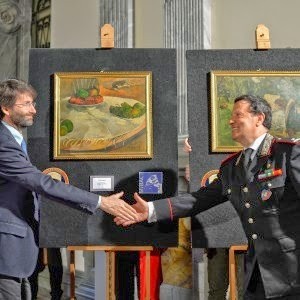 Minister Franceschini and Carabinieri General Mariano Mossa at press conference, 2 April 2014 (afp) The paintings are truly beautiful. Here's the Gauguin, titled Fruits sur une table ou nature morte au petit chien:
Minister Franceschini and Carabinieri General Mariano Mossa at press conference, 2 April 2014 (afp) The paintings are truly beautiful. Here's the Gauguin, titled Fruits sur une table ou nature morte au petit chien:

And here's the Bonnard called La femme aux deux fauteuils:

Imagine living with such splendor for 40 years! The press says the guy put it in his kitchen - that sounds a lot more newsworthy - but it is not fair. He put it in his living room and as he was a simple blue-collar worker, the living room had a kitchen corner, he couldn't afford more...
In fact, I got curious about this man. And I discovered a few things about him in the Italian newspapers (see here and here). He is now 70 years old, retired and lives in his hometown, Syracuse, Sicily (a beautiful town I know well, it's my husband's hometown too).
His name is Nicolà, and like so many southerners of his generation, he spent his life working "in the North", in Turin, doing long night shifts in a Fiat factory. But unlike his fellow workers, he didn't spend his money on booze in bars but liked to save it to participate in the yearly auction of "lost objects" organized by the Italian Railways, in that "beautiful room behind the train station of Porta Nova", as he put it.
He still remembers that morning in the spring of 1975 when he bought the paintings. A beautiful sunny day, he was 34 years old and full of hope. He particularly wanted the Bonnard and counted on getting both paintings at the lowest possible price - obviously with a monthly salary of 200,000 Lire, he couldn't afford high prices. The two paintings hadn't been recognized as valuable - indeed, at the auction they were thought of as "trash", they were expected to go around 50,000 Lire. No one made a bid at the first turn and his hopes were high that he might make a killing at the second turn, starting at 40,000 Lire. Unfortunately someone suddenly woke up and started bidding. He had to fight for them, with hikes of 500 Lire at every turn. He finally got them for 45,000 Lire, a quarter of his monthly salary, quite a lot for him.
He didn't have any idea of the value of these paintings, until much later, when his son, 15 years old at the time, who loved the paintings too, got interested. He thought he could read the signature in one of them, the Bonnard, and deciphered "Bonnato", which of course got him nowhere. Later, when he was studying architecture (yes, Italian society does have social upward mobility!), he bought a Bonnard biography and discovered a picture of Bonnard's garden that was exactly like the garden in the painting his father had bought.
Father and son contacted the Italian Art Bureau (Sovrintendenza) to no avail, they were turned away and told that their story was "impossible" and they shouldn't waste their time with it. Only the Carabinieri listened to them. That is how it was discovered that the paintings belonged to a wealthy couple who lived in London and who had died since without heirs.
Obviously, at this point father and son are hoping no heir will ever be found and that they can recover the paintings for their living room - as of now, they are under the Carabinieri's custody. After all, Nicolò bought the paintings in good faith from a State auction, and he bought them because he loved them...The best reason to buy art!
One wonders whether in future lost conceptual art would find the same fate. Some of it, yes, as long as it is art meant to please and comfort. Unfortunately, too much of contemporary art is meant to astonish and shock, not exactly the sort of thing you'd want to have in your living room, let alone your kitchen...
But of course, that's what Picasso always said of his own work: that he would never want to have a painting of his hanging in someone's living room. There was this deep "hatred of the bourgeois" (especially bourgeois living rooms!) that has been transmitted to most young artists today. Personally, I think that's a shame. When you come across the love of art in simple people, like in this case, it's quite simply a wonderful, moving experience that restores one's faith in humanity. The love of Beauty is the one thing that sets humans apart from animals...
Your views?










The Italian Carabinieri that are tasked with the defense of cultural patrimony recently reported on it, earning the compliments of the Italian Minister of Culture:
 Minister Franceschini and Carabinieri General Mariano Mossa at press conference, 2 April 2014 (afp) The paintings are truly beautiful. Here's the Gauguin, titled Fruits sur une table ou nature morte au petit chien:
Minister Franceschini and Carabinieri General Mariano Mossa at press conference, 2 April 2014 (afp) The paintings are truly beautiful. Here's the Gauguin, titled Fruits sur une table ou nature morte au petit chien:
And here's the Bonnard called La femme aux deux fauteuils:

Imagine living with such splendor for 40 years! The press says the guy put it in his kitchen - that sounds a lot more newsworthy - but it is not fair. He put it in his living room and as he was a simple blue-collar worker, the living room had a kitchen corner, he couldn't afford more...
In fact, I got curious about this man. And I discovered a few things about him in the Italian newspapers (see here and here). He is now 70 years old, retired and lives in his hometown, Syracuse, Sicily (a beautiful town I know well, it's my husband's hometown too).
His name is Nicolà, and like so many southerners of his generation, he spent his life working "in the North", in Turin, doing long night shifts in a Fiat factory. But unlike his fellow workers, he didn't spend his money on booze in bars but liked to save it to participate in the yearly auction of "lost objects" organized by the Italian Railways, in that "beautiful room behind the train station of Porta Nova", as he put it.
He still remembers that morning in the spring of 1975 when he bought the paintings. A beautiful sunny day, he was 34 years old and full of hope. He particularly wanted the Bonnard and counted on getting both paintings at the lowest possible price - obviously with a monthly salary of 200,000 Lire, he couldn't afford high prices. The two paintings hadn't been recognized as valuable - indeed, at the auction they were thought of as "trash", they were expected to go around 50,000 Lire. No one made a bid at the first turn and his hopes were high that he might make a killing at the second turn, starting at 40,000 Lire. Unfortunately someone suddenly woke up and started bidding. He had to fight for them, with hikes of 500 Lire at every turn. He finally got them for 45,000 Lire, a quarter of his monthly salary, quite a lot for him.
He didn't have any idea of the value of these paintings, until much later, when his son, 15 years old at the time, who loved the paintings too, got interested. He thought he could read the signature in one of them, the Bonnard, and deciphered "Bonnato", which of course got him nowhere. Later, when he was studying architecture (yes, Italian society does have social upward mobility!), he bought a Bonnard biography and discovered a picture of Bonnard's garden that was exactly like the garden in the painting his father had bought.
Father and son contacted the Italian Art Bureau (Sovrintendenza) to no avail, they were turned away and told that their story was "impossible" and they shouldn't waste their time with it. Only the Carabinieri listened to them. That is how it was discovered that the paintings belonged to a wealthy couple who lived in London and who had died since without heirs.
Obviously, at this point father and son are hoping no heir will ever be found and that they can recover the paintings for their living room - as of now, they are under the Carabinieri's custody. After all, Nicolò bought the paintings in good faith from a State auction, and he bought them because he loved them...The best reason to buy art!
One wonders whether in future lost conceptual art would find the same fate. Some of it, yes, as long as it is art meant to please and comfort. Unfortunately, too much of contemporary art is meant to astonish and shock, not exactly the sort of thing you'd want to have in your living room, let alone your kitchen...
But of course, that's what Picasso always said of his own work: that he would never want to have a painting of his hanging in someone's living room. There was this deep "hatred of the bourgeois" (especially bourgeois living rooms!) that has been transmitted to most young artists today. Personally, I think that's a shame. When you come across the love of art in simple people, like in this case, it's quite simply a wonderful, moving experience that restores one's faith in humanity. The love of Beauty is the one thing that sets humans apart from animals...
Your views?










Published on April 05, 2014 01:07
March 28, 2014
Ukraine Crisis: A Return to the Cold War?

The West has loudly condemned Putin and his grab on Crimea, forgetting that for most of its history, Crimea belonged to Russia and that it was only absent-mindedly handed over to the Ukraine some 60 years ago by Krushchev. This was a time when the Soviet Union was so solid that it was impossible to imagine that it might collapse some day, much less fragment the way it did.
Putin is obviously a nostalgic politician dreaming of putting the broken Soviet giant back together again via his EuroAsian Union proposal (so far only joined by Belarus and Khazakstan).
But Putin's nostalgia is not something to take lightly. Russia's economy may well be no larger than Italy's, and Putin may rely excessively on carbon energy and gaz rather than attempt to build a diverse economy for the future (which would be much wiser), but his Russia is still a major nuclear power and therefore not to be trifled with.
Then, consider the effect of globalization: Russia is a major trading partner and provider of energy for Western Europe and Germany in particular. Practically all big banks in the West are exposed to Eastern Europe including Ukraine and Russia, but the Europeans (for example Italy's Unicredit) much more so than the Americans.
These economic links only mean one thing: any attempt to impose broad economic sanctions following the model applied to Iran would only backfire and most likely put paid to Europe's on-going recovery (that is still very weak and iffy).
Obama has been loudly asking for Russia to pull back from Crimea and Ukraine. Merkel a little less loudly, and that's understandable, she has no wish to risk an economic recession - and a lot of European leaders are dragging their feet, uncertain of what is the next step.
So the dispute has been moved up to the United Nations. The General Assembly has been drawn into the act in a resolution supporting Ukraine territorial integrity, with 100 voting in favor, 11 voting against and, what is important in this case: 58 abstentions (24 countries did not vote). Out of a total 193 members, a little more than half were mobilized in favor (for details see news report here )
The US made the case that while self-determination is a UN principle, it is not valid when the voting is held "under coercion" as was done in Crimea - something Russia of course denies (!).
The outcome of the UN vote, while giving strong support to the US position, does suggest that for a lot of countries, those that abstained or didn't turn up to vote, the situation is not quite so clear cut and they've adopted a wait-and-see attitude. Notably, the BRICs abstained: China, India, Brazil and South Africa.
Those voting against along with Russia, were the usual culprits: Armenia, Belarus, Bolivia, Cuba, North Korea, Nicaragua, Sudan, Syria, Venezuela and Zimbabwe.
The biggest move - more important than the piddly sanctions against people in Putin's entourage (freezing their assets abroad and forbidding travel to the West) - has been the ejection of Russia out of the G-8, which is now effectively back to a G-7. And the next meeting which was supposed to be hosted by Putin and held in Sochi this summer won't take place.
Of course. Thus Putin is now effectively isolated. Alone on the international scene.
Is that clever?
What do you think? In my view, this is both a dangerous and stupid game. Kicking Russia out of the G-8 has effectively removed one major forum where Putin could have been tackled. One chance less to try and curb him.
Shaming him in front of the UN General Assembly might have given Obama the feeling he had achieve something, but in fact it has no practical consequences. Resolutions in the General Assembly, unlike those of the UN Security Council, are not legally binding. And naturally, a UN Security Council resolution is unthinkable since Russia is one of the five countries with veto power.
Result of this move? It makes the UN appear in Putin's eyes as a supremely unfriendly environment. Not a place where he is going to want to go and discuss the territorial integrity of anything at all.
We are now effectively back into a Cold War situation where diplomatic channels tend to be frozen . And when diplomacy is frozen, the military elbow in and strut on stage - with the consequences we all know. No doubt to the glee of gun merchants and the military-industrial complex.
Not clever at all.
Your views?
Photo credit: Vladimir Putin - Olympic Host see: DonkeyHotey










Published on March 28, 2014 08:20
March 24, 2014
Why Climate Change is Only a Side Show: the Sixth Extinction is Upon Us!
 In the United States, Climate Change is viewed with suspicion: many Americans don't believe in it, at best they'll agree that climate warming may have natural causes but they strongly refute the idea that it could be due to human action. And in any case, they reject any causal linkage with extinction of life on earth. Life has survived long periods of colder and warmer climate, they argue, and there's no reason to believe that this time will be any different, regardless of who's responsible for the warming - and supposing the warming actually occurs.
In the United States, Climate Change is viewed with suspicion: many Americans don't believe in it, at best they'll agree that climate warming may have natural causes but they strongly refute the idea that it could be due to human action. And in any case, they reject any causal linkage with extinction of life on earth. Life has survived long periods of colder and warmer climate, they argue, and there's no reason to believe that this time will be any different, regardless of who's responsible for the warming - and supposing the warming actually occurs. For a strong statement expressing this viewpoint, see here, "global warming debunked" by Gary Ellis, who describes himself as an electrical engineer "with 40-plus years of work experience in electrical generation from methane gas to coal, natural gas and nuclear." Incidentally, not a climate specialist but a person whose life has been invested in energy extraction.
Right. You can always argue as he does that the science behind Climate Change is not strong enough or persuasive, that there's a political agenda behind it. Whose agenda is never spelled out though the agenda of people debunking climate warming is pretty clear: they want to defend their kind of economy based on energy extraction that spews out tons of carbon in the air. Just ask the Chinese authorities and watch what they do to control the smog in Beijing. They're the ones (along with India) who constantly defeat United Nations discussions on Climate Change and how to control it.
But this discussion is sterile when confronted with the actual numbers out there: the numbers describe an alarming increase in the rate of extinction of species that often have been around for millions of years (like amphibians) and yet are headed for extinction - in some cases, right now. The rate in extinction is so massive that scientists have taken to calling it the Sixth Extinction - there were five before, notably the one that killed off the dinosaurs (that one was caused by an asteroid impacting the earth and causing the equivalent of a "nuclear winter"). But this one, the Sixth, is shaping up to be bigger than any other, the biggest ever, and it is caused by...yes, us, humans.
Think of it. We've covered the earth, all 7 billions of us soon to become 8, 9, 10 billions - there seems to be no end to the population explosion. We use up every available natural resource, we cover the earth with our buildings, we shape the landscape, we travel everywhere, bringing seeds and species along in our baggage, thoughtlessly putting local biodiversity at risk. Big changes are in the offing: the disappearance of amphibians caused by the spread of a fungus, the fast acidification of the oceans that threaten the survival of reefs and all life in them, the extinction of bats in the United States - even our outdoor cats can be a cause of extinction as they relentlessly kill birds.
I read about the cats (some 80 million of them in the US) yesterday in the International New York Times (see here: "That Cuddly Kitty is Deadlier Than You Think"): yes, a recent study has shown that sweet cats, some of the best companions we have, are among the most feral predators and given the facts of rapidly rising urbanization and modern agriculture reducing forest space, birds have few places left to breed and live. Add cats to the mix, and there you go: a silent spring!
This is a horror story and it is excellently described by New Yorker journalist Elizabeth Kolbert in her book The Sixth Extinction, an Unnnatural History - now a #1 bestseller on Amazon in biology and a must read for anyone remotely interested in what the future holds for us. She expertly takes us along for the ride as she herself travels around and interviews scientists, often following them in their investigations. All this makes for a very human and effective read, in my view, Pulizer Prize stuff!
What I like best about it, is that she cleverly avoids the confrontation with Climate Change: it is obvious that it enters the equation, it is a fallout of our activities but if you believe it is not, in fact, it doesn't matter. It doesn't change the thrust of the arguments about the Sixth Extinction or the results of observation. The data showing the on-going extinction is not anybody's invention, it is solid science and cannot be debated or refuted like climate warming. As Kolbert says, even if you find a totally clean energy (say fusion), what would matter is whether you continue to cut down the rain forest. Some of those biologists interviewed by Kolbert have no doubts: human life is headed for extinction and what will follow are...giant rats!
The rate of the current extinction? Scientists believe that up to 50 percent of existing species will have disappeared by the end of the century. Fast! And inevitable, it is already on-going. Nothing in our political set-up (especially at the United Nations where everyone is allowed to speak, including those who don't understand the issues: see the failure in Copenhagen, here) permits us to think that we can escape the ultimate outcome. We might have the science to do it but we won't do it for political reasons.
For me, the book was an eye-opener and I highly recommend it. This is of course why I have set my upcoming book "Forever Young" some 200 years from now (btw, it's nearly finished, I'm going through the last edits - expect it soon!). Kolbert's book came out just in time to confirm my timing and give me extra confidence in the world I envision in "Forever Young" - a world that is not only sharply divided between the haves and have-nots, with every costly technological advance going to the ultra rich who can afford it. It is also a world threatened with extinction - and again, only the ultra rich have escape options. Some decide to fly to another pristine planet, others to take refuge on the last virgin continent, Antarctica, and wait there, in a protected environment, for the end of life - with the intention of resettling the earth once the Sixth Extinction is over. But this is a novel, not a scholarly treatise of futurology. So I've thrown in that future world people like you and me who have to figure out what to do - and still try to live a full life and know happiness in love. But is it possible when everything collapses around you? The answer in "Forever Young"...
In a way, I see this book "Forever Young" as my own contribution to the debate, or, if you will, "duty of care". As Kolbert reports, paraphrasing Sherwood Rowland, one of the scientists who discovered ozone depleting chemicals, “What’s the use of having predictive science if you don’t listen to the predictions?”
My hope is that people who read "Forever Young" will start to listen to the predictions and do something about it... And here's a fun (?) video - anyway worth watching:
Related articles
 Finished Reading: The Sixth Extinction By Elizabeth Kolbert(consilientinterest.com)
Finished Reading: The Sixth Extinction By Elizabeth Kolbert(consilientinterest.com)
 Elizabeth Kolbert On How Tech Can, and Can't, Tackle Climate Change and Extinction(recode.net)
Elizabeth Kolbert On How Tech Can, and Can't, Tackle Climate Change and Extinction(recode.net)
 Ignoring climate facts won't change outcome(thegazette.com)
Ignoring climate facts won't change outcome(thegazette.com)
 Elizabeth Kolbert on "The Sixth Extinction"(climatesciencewatch.org)
Elizabeth Kolbert on "The Sixth Extinction"(climatesciencewatch.org)










Published on March 24, 2014 09:10
March 21, 2014
Do Artists and Writers Have a "Duty of Care"?
In terms of not just democracy but of caring for others, for their well-being and happiness, does an artist have "duty of care"? If you're a writer, whether fiction or non-fiction, whether a contributor to a paper or a blogger on the Net, should you be concerned with the moral value of what you write?
David Putnam thinks you should. See here:
He's talking about the media but he makes it clear that it applies to artists and writers too.
Personally, as a writer, I'm totally convinced he's right. Injecting a cause in story-telling isn't necessary of course, but it is desirable. It is part of "duty of care".
One striking example has recently come up: a reality show on MTV, "16 and Pregnant", a huge hit since it came out in 2009, had the remarkable effect of slowing down teenage pregnancies, a scourge in the United States that, among developed countries, has the highest birthrate rate among teenagers (American girls are ten times as likely to have a baby as Swiss girls, and twice as likely as Canadians). Nicholas Kristof just wrote about it in the New York Times (see here) attributing the remarkable slowdown experienced in the US to that show and its several spin-offs.
It is proof that if you inject a cause into a good story, and people enjoy it and start to think about it, your cause will be given a strong boost. It works better than any policy or educational measure. In the case of teenage pregnancies, it has proved to work better than sex education and condom distribution.
This said, I would like to add my grain of salt. I notice that artists - especially contemporary artists - love to attack society and highlight what's wrong (just about everything if one is to believe them). Of course, who can disagree, so much is wrong with our society...
But continuous bashing doesn't get us anywhere. Ditto for writers. The trouble is that intellectuals who are most effective at bringing down society, who come up with the most convincing (and damning) arguments are those who sell the most .
It's as if people LOVE to hear in detail everything that's wrong with our society. They buy those books, they buy the art.
But what about coming up with answers? Solutions to the problems?
Personally, I see that as a crucial part of the "duty of care" - if you only attack and destroy, you're not really doing your part, only the half of it. Of course, to offer solutions is a lot less exciting than coming up with criticisms and it is also much more complex...It doesn't make for easy-to-read articles or books, it doesn't perversely titillate the reader the way a book with a negative message does.
Just one example to illustrate what I mean: think of the Euro and the construction of a United Europe. It's a lot easier to damn the Euro and laugh at the notion of a United Europe than to propose a solid European Union building strategy.
Alas, the criticism is easy to come up with and sells easily...No wonder that one third of the electorate across Europe dreams of nothing than a return to national currencies and a shutting down of Brussels. Yet, those millions of people who feel that way (for example, those led by Beppe Grillo in Italy and Marine Le Pen in France) have no real understanding of :
the complexity of the situation: you can't give up the Euro without engineering a depression that will make the Great Recession look like kid's play; or the political stakes: do we really want to return to a pre-World War II political situation? Have we all forgotten how easily wars are waged in Europe?? To sum up: a negative message sells better than a positive one . Intellectuals, artists and writers, as a result, are tempted to convey negative messages that threaten the very foundations of society...all the while, claiming for themselves "duty of care".
Your views?
Related articles What Is Duty Of Care?(personalinjuryplace.com)
What Is Duty Of Care?(personalinjuryplace.com)
 Duties of Care, from Cockroaches to Kindy Kids(ithinkicanonline.com)
Duties of Care, from Cockroaches to Kindy Kids(ithinkicanonline.com)










David Putnam thinks you should. See here:
He's talking about the media but he makes it clear that it applies to artists and writers too.
Personally, as a writer, I'm totally convinced he's right. Injecting a cause in story-telling isn't necessary of course, but it is desirable. It is part of "duty of care".
One striking example has recently come up: a reality show on MTV, "16 and Pregnant", a huge hit since it came out in 2009, had the remarkable effect of slowing down teenage pregnancies, a scourge in the United States that, among developed countries, has the highest birthrate rate among teenagers (American girls are ten times as likely to have a baby as Swiss girls, and twice as likely as Canadians). Nicholas Kristof just wrote about it in the New York Times (see here) attributing the remarkable slowdown experienced in the US to that show and its several spin-offs.
It is proof that if you inject a cause into a good story, and people enjoy it and start to think about it, your cause will be given a strong boost. It works better than any policy or educational measure. In the case of teenage pregnancies, it has proved to work better than sex education and condom distribution.
This said, I would like to add my grain of salt. I notice that artists - especially contemporary artists - love to attack society and highlight what's wrong (just about everything if one is to believe them). Of course, who can disagree, so much is wrong with our society...
But continuous bashing doesn't get us anywhere. Ditto for writers. The trouble is that intellectuals who are most effective at bringing down society, who come up with the most convincing (and damning) arguments are those who sell the most .
It's as if people LOVE to hear in detail everything that's wrong with our society. They buy those books, they buy the art.
But what about coming up with answers? Solutions to the problems?
Personally, I see that as a crucial part of the "duty of care" - if you only attack and destroy, you're not really doing your part, only the half of it. Of course, to offer solutions is a lot less exciting than coming up with criticisms and it is also much more complex...It doesn't make for easy-to-read articles or books, it doesn't perversely titillate the reader the way a book with a negative message does.
Just one example to illustrate what I mean: think of the Euro and the construction of a United Europe. It's a lot easier to damn the Euro and laugh at the notion of a United Europe than to propose a solid European Union building strategy.
Alas, the criticism is easy to come up with and sells easily...No wonder that one third of the electorate across Europe dreams of nothing than a return to national currencies and a shutting down of Brussels. Yet, those millions of people who feel that way (for example, those led by Beppe Grillo in Italy and Marine Le Pen in France) have no real understanding of :
the complexity of the situation: you can't give up the Euro without engineering a depression that will make the Great Recession look like kid's play; or the political stakes: do we really want to return to a pre-World War II political situation? Have we all forgotten how easily wars are waged in Europe?? To sum up: a negative message sells better than a positive one . Intellectuals, artists and writers, as a result, are tempted to convey negative messages that threaten the very foundations of society...all the while, claiming for themselves "duty of care".
Your views?
Related articles
 What Is Duty Of Care?(personalinjuryplace.com)
What Is Duty Of Care?(personalinjuryplace.com)
 Duties of Care, from Cockroaches to Kindy Kids(ithinkicanonline.com)
Duties of Care, from Cockroaches to Kindy Kids(ithinkicanonline.com) 









Published on March 21, 2014 03:24
March 18, 2014
Ukraine: The Unnecessary Crisis
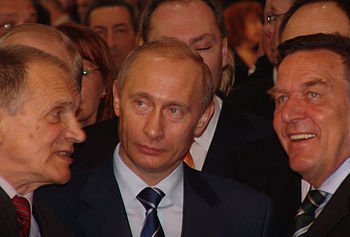 Vladimir Putin with Gerhard SchroederWith Crimea voting to secede and Ukraine torn between the pro Russian East and anti-Russian West, not to mention the Muslem ethnic minority, it looks like a balkanization of Ukraine - and perhaps even a Cold War scenario if you throw in American and European indignant reactions and calls for sanctions against Russia.
Vladimir Putin with Gerhard SchroederWith Crimea voting to secede and Ukraine torn between the pro Russian East and anti-Russian West, not to mention the Muslem ethnic minority, it looks like a balkanization of Ukraine - and perhaps even a Cold War scenario if you throw in American and European indignant reactions and calls for sanctions against Russia.But is all this hullaballoo really needed? After all, Putin is playing in his own backyard. Crimea is part of Russian History and an emotional part too - one million russians lost their lives in Crimea fighting the nazi occupants in World War II. People have a right to auto-determination, don't they?
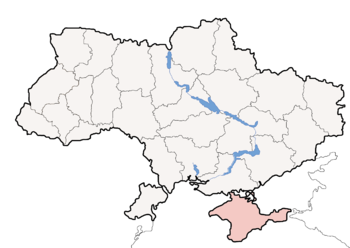
Yet Obama and Merkel in primis will have none of it, rejecting any notion of geo-political regions. As soon as the results of the referendum in Crimea were in and Putin claimed victory, they called for sanctions. The sanctions passed were actually puny and aimed at a handful of individuals in Putin's entourage, carefully avoiding Putin himself, of course.
Why bother with sanctions at all? Personally, as an economist, I'm dead set against economic sanctions of any kind, including the "big variety" aimed at a whole country (and not just a few individuals as here). Historically, sanctions have been shown never to work, starting with the most famous one, Napoleon's blockade of Europe, aimed at the British - we know with what scant results! Sanctions always create a black market and inevitably hurt the poor while filling the pockets of speculators.
Sanctions should never be used by any responsible political leader.But are our leaders responsible? I seriously doubt it.
On the very day the sanctions were passed, two major deals were concluded with Russian businessmen: Rosneft invested in Pirelli, the giant Italian tire manufacturer becoming its top investor, and two Russian billionaires invested $7.1 billion in the troubled German energy utilities company RWE, buying an oil and gas unit that gave them access to the U.K., Germany and the North Sea (see here and here).
This just shows the strength of market globalization. Annual trade figures, both ways, between Germany and Russia are in the neighborhood of $37 billion. Russia is a major oil and gas supplier to Europe. Under the circumstances, is war conceivable? Of course not.
The problem in Ukraine - now that Crimea has seceded - is what happens to the eastern, russophone region. This is what diplomacy should focus on: the goal is to create a federal Ukrainian state that respects everyone's identity (language and religion) and is recognized by Russia, rather than waste time on threatening further sanctions - as Ms. Merkel does, unless she means that as a move in a complex chess game she is playing against Putin? Maybe so.
In any case, what is not needed here is any American intervention. This is a purely European crisis - if it has to be a crisis at all. The hope is that our leaders, Merkel included, will see the light of day and understand the way out - through negotiations, not sanctions, and much less a military intervention which is unthinkable, or if thought of, profoundly stupid.
Related articles
 Putin notifies Russian officials of Crimea's bid(usnews.com)
Putin notifies Russian officials of Crimea's bid(usnews.com)
 Ukraine crisis escalates as US, Europe hit Russians with sanctions(smh.com.au)
Ukraine crisis escalates as US, Europe hit Russians with sanctions(smh.com.au)
 Obama Says Putin Must Pull Back on Crimea Annexation(glblgeopolitics.wordpress.com)
Obama Says Putin Must Pull Back on Crimea Annexation(glblgeopolitics.wordpress.com)










Published on March 18, 2014 03:35

